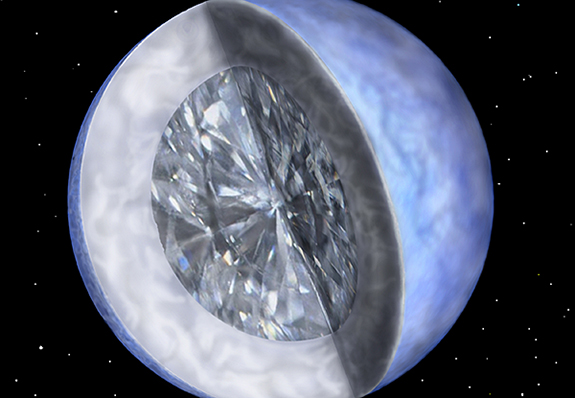Astronomers Identify White Dwarf Star That's Crystallizing Into a Diamond
An international team of astronomers has discovered a white dwarf star that's in the early stages of crystallizing into a cosmic diamond.
A white dwarf star is the compressed dying remnant of a star much like our Sun. But, once a star uses up its fuel, it shrinks in on itself and starts to cool off. Since it’s made mostly of carbon, the crystallization of the super-dense material produces a diamond.
The team led by Alexander Venner of the University of Southern Queensland in Australia identified a white dwarf star dubbed HD 190412 C in a quadruple star system called HD 190412. Although it's 104 light-years away, the researchers were able to peg the star's temperature at about 11,420 degrees Fahrenheit (6,300 degrees Celsius).
That seems blazing hot, but it's cool for a star.
According to the researchers, the temperature-mass profile of HD 190412 C suggests that the core of the star is starting to transform into a dense "cosmic diamond" made up of crystallized carbon and oxygen. Their findings are detailed in a paper accepted for publication in the journal Monthly Notices of the Royal Astronomical Society.
Before we too excited about the prospect of a mining mission to a distant star, we need to wrap our heads around just how far the white dwarf is from Earth and how long it will take the crystallization process to complete.
The 104 light-year distance from Earth to white dwarf HD 190412 C is equivalent to 610 trillion miles — or about 95,000 round-trips from Earth to Pluto.
What's more, the researchers did the math and determined that the time for a white dwarf star to transition into a stone-cold diamond would be about a "quadrillion" years (that's a million billion years).
This is not the first time astronomers have speculated about a star made of diamonds.
Back in 2004, researchers at the Harvard-Smithsonian Center for Astrophysics identified a white dwarf star 50 light-years away in the constellation Centaurus. The astronomers playfully promoted the star as the galaxy's largest diamond. They even calculated its weight in jewelry-industry terminology, at 10 billion trillion trillion carats.
The astronomers called the white dwarf “Lucy” as a nod to the Beatles’ classic song, “Lucy In The Sky With Diamonds.” Officially, the dwarf star is known as “BPM 37093.”
The study of white dwarf stars is extraordinarily challenging because they are extremely difficult to see. Lucy, for example, shines today with only 1/2000th of our Sun's visual brightness.
Lacking visual clues, astronomers have relied on other methods to pinpoint a white dwarf in space. Lucy happens to do an “orbital tango” with a pulsar, or fast-spinning neutron star.
HD 190412 C shares a gravitational bond with its three sister stars in a quadruple star system. Because the other stars in the system have not degraded to white dwarf status, the researchers were able to study them to determine the likely composition of the white dwarf's core.
In the future, white dwarf star hunters will be utilizing the data derived from the European Space Agency's Gaia project, which is surveying nearly two billion cosmic objects to create the most precise three-dimensional map of our galaxy. White dwarf stars may be hard to see, but Gaia has the ability to measure the positions of objects are extremely faint — 400,000 times fainter than can be seen with the naked eye.
Credit: Illustration by Harvard-Smithsonian Center for Astrophysics / Travis Metcalfe, Christine Pulliam, Ruth Bazinet.







